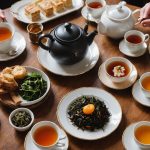Traditional British cuisine deserves an elevated touch, and what better way to enhance it than through the art of tea pairing? Unique tea pairings can transform a classic menu, offering guests an intriguing fusion of flavors and aromas that celebrate both heritage and innovation. This guide explores creative tea options that complement various dishes, allowing your restaurant to stand out and provide a memorable dining experience. Discover how to craft pairings that delight the senses and create meaningful connections in every cup.
Understanding Tea in British Cuisine
Exploring the significance and evolution of tea culture in Britain
Additional reading : Enhancing Dining Experiences: Smart Strategies for Restaurants to Personalize Service Using Customer Data While Respecting Privacy
Historical Context of Tea in Britain
Tea holds a prominent place in British culinary traditions, deeply intertwined with the nation's history. Introduced in the 17th century, tea quickly became a symbol of sophistication and social status. The British tea history began with the East India Company, which played a crucial role in importing this exotic beverage. Over time, tea became more accessible to the general population, evolving from a luxury item to a staple in everyday life.
The Evolution of Tea Culture
The evolution of tea culture in Britain reflects broader social changes. From the traditional afternoon tea to the modern tea rooms, the way tea is consumed has transformed dining experiences. Tea culture has adapted to contemporary lifestyles, yet it retains its essential role as a social ritual. This adaptability highlights the enduring significance of tea in British society.
Also read : Elevating Restaurant Aesthetics: Creative Strategies for Integrating Acoustic Panels
Tea's Role in British Culinary Traditions
- Afternoon Tea: A light meal with tea, sandwiches, and pastries.
- High Tea: A more substantial meal, often including meats and bread.
- Tea Rooms: Social spaces for enjoying tea and conversation.
Tea's influence extends beyond the cup, shaping the very fabric of British dining. Its significance in culinary traditions underscores its lasting impact on British culture.
Selecting Teas for Pairing
Exploring the variety and flavors in tea selection
Popular Tea Types
Choosing the right types of tea for pairing can significantly enhance your dining experience. Black tea, with its robust flavor, is a classic choice for pairing with savory dishes. Green tea offers a lighter, more refreshing taste, perfect for complementing delicate flavors. Herbal teas, such as chamomile or peppermint, provide versatile options with unique flavor profiles that can match a variety of foods.
Importance of Flavor Profiles
Understanding flavor profiles is crucial in selecting tea. The astringency of black teas can cut through rich, fatty foods, while the earthy notes of green tea can balance spicy dishes. Oolong tea offers a complex profile, suitable for pairing with both sweet and savory meals. Consider the aroma, body, and finish when matching tea with food.
Sourcing High-Quality Teas
Sourcing high-quality teas ensures the best flavor and aroma. Look for loose-leaf teas over tea bags, as they often provide a fuller taste. Consider the origin and processing methods, as these factors influence the tea's quality.
- Black Tea: Strong, bold
- Green Tea: Fresh, grassy
- Herbal Tea: Diverse, aromatic
Selecting the right tea involves understanding both the types of tea and their flavor profiles, ensuring a delightful pairing experience.
Complementary Food Pairings
Exploring the harmony between food and tea
Guidelines for Pairing Teas with Traditional British Dishes
Pairing food and tea involves understanding the flavor combinations that enhance both elements. Traditional British dishes, like fish and chips or shepherd's pie, can be elevated with the right tea. For instance, a robust black tea complements the rich, savory notes of meat pies, while a light green tea balances the flavors of fish dishes.
Examples of Specific Tea and Food Pairings
Consider these examples for a delightful pairing experience:
- Black Tea: Pairs well with roast beef or hearty stews.
- Green Tea: Ideal with fish and chips or cucumber sandwiches.
- Oolong Tea: Complements scones with cream and jam.
Creative Ideas for Incorporating Tea into Modern Recipes
Incorporating tea into modern recipes can add a unique twist to traditional dishes. Use herbal teas as a marinade base for meats, or infuse desserts with floral teas for a subtle aroma. Experimenting with flavor combinations allows for creative culinary expressions.
| Tea Type | Traditional Dish | Modern Twist |
|---|---|---|
| Black Tea | Roast Beef | Tea-infused gravy |
| Green Tea | Fish and Chips | Green tea batter |
| Herbal Tea | Shepherd's Pie | Herbal tea-infused mashed potatoes |
These food and tea pairings not only respect tradition but also encourage innovation in the kitchen.
Presentation and Serving Ideas
Enhancing the aesthetic and experience of tea service
Tips for Visually Appealing Tea Presentation
Creating a visually appealing tea presentation elevates the entire dining experience. Consider using elegant teapots and cups that complement the theme of your event. Colorful garnishes, such as edible flowers or lemon slices, can add a pop of color. Arranging tea leaves in small, clear containers allows guests to appreciate the tea's aroma and texture before brewing.
Suggested Serving Techniques
Serving techniques play a crucial role in enhancing the enjoyment of tea. Pre-warm the teapot and cups to maintain the ideal temperature. Use a tea timer to ensure perfect brewing, avoiding over-steeping. For a sophisticated touch, offer a selection of sugar cubes or honey sticks on a decorative tray. These small details contribute to a memorable dining experience.
Ideas for Themed Tea Pairings or Events
Themed tea pairings can transform a simple gathering into a unique event. Consider hosting a Victorian tea party with period-appropriate tableware and attire. Alternatively, a seasonal tea event can feature teas and foods that reflect the flavors of the current season. Such themed events create a cohesive and immersive dining experience for guests.
| Theme | Suggested Tea Types | Serving Accessories |
|---|---|---|
| Victorian | Black, Herbal | Lace tablecloths, Fine china |
| Seasonal | Green, Oolong | Rustic wooden trays |
Customer Experiences and Testimonials
Exploring tea enthusiasts' insights and feedback
Insights on Customer Preferences
Understanding customer preferences is crucial for creating memorable dining experiences. Tea enthusiasts often seek unique tea pairings that enhance their meals, favoring combinations that highlight both the tea's and the food's flavors. This desire for innovative pairings drives establishments to experiment with diverse flavor profiles, ensuring that each dining experience is both satisfying and distinctive.
Highlighting Testimonials from Previous Events
Testimonials from tea enthusiasts reveal the impact of curated tea pairing events. One customer noted, "The thoughtful tea pairings elevated the meal to an unforgettable experience." Such feedback underscores the importance of aligning customer preferences with creative culinary offerings. By listening to guests, tea events can continuously evolve, ensuring high levels of customer satisfaction.
Impact on Customer Satisfaction and Loyalty
Unique tea pairings not only enhance the dining experience but also foster customer loyalty. Guests who enjoy well-curated tea events are more likely to return and recommend the experience to others. Establishments that prioritize customer satisfaction by offering personalized tea choices often see increased patronage and positive word-of-mouth.
- Customer Preferences: Diverse, innovative
- Tea Pairings: Personalized, memorable
- Customer Satisfaction: High, loyalty-building
These insights highlight the significance of understanding and adapting to customer preferences, ensuring lasting customer satisfaction and loyalty.











